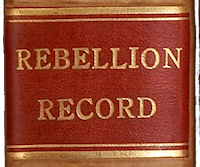October 15.—The United States steamer Roanoke took possession of the ship Thomas Watson, which, in the attempt to run the blockade at Charleston, had got on Stone reef and was abandoned by the captain and crew. She was laden with an assorted cargo, which, with the ship, was thought to be worth about a hundred thousand dollars. She was burned.—N. Y. Herald, Oct. 24.
—The Confederates burned the house of the widow Childs, situated about half way between Falls Church and Lewinville, Va., to the right of the Leesburg turnpike. A party of ten of the New York Fourteenth regiment went thither to ascertain the cause of the conflagration, when they were surrounded by a largely superior force of Confederates, but by the prompt use of their rifles, killing two of the enemy, they escaped.—The naval fleet which left New York on Monday arrived in Hampton Roads this day, and created a great excitement among the troops, owing to the extensive character of the expedition. A flag of truce came up from Norfolk, but Gen. Wool refused to receive it.—The armed steamer Pawnee left the Navy Yard, at Washington, for Fortress Monroe, with a battalion of marines. As the Pawnee got abreast of the secession batteries above Acquia Creek, about fifty shell and shot were fired at the steamer, but having been ordered not to return any fire unless she were struck, and no shot taking effect on her, she went on her way down the river unharmed.—National Intelligencer, October 17.
—The Second Minnesota regiment, under the command of Colonel Henry P. Van Cleve, passed through Chicago, Ill., on the way to the seat of war on the Potomac.—Chicago Tribune, October 16.
—The Connecticut Senate, by a vote of twelve to six, this morning passed the following: “Resolved, That the messenger of the Senate be, and is hereby requested and directed to remove from the Senate Chamber the portraits of Isaac Toucey and Thomas H. Seymour, and that whenever the comptroller shall be satisfied of their loyalty he is instructed to return their portraits to their present place on the wall.”
—Six Hundred rebels, under Jeff. Thompson, attacked forty U. S. soldiers, posted to guard the Big River Bridge, near Potosi, in Missouri. Though the Union troops fought bravely for a while, they were surrounded and compelled to surrender. Their loss was one killed and six wounded; the rebel loss was five killed and four wounded. Immediately after the surrender, the Federal prisoners were sworn by Jeff. Thompson not to bear arms against the Southern Confederacy, and released. The rebels then burned the bridge and retreated. All the troops along the road, when this became known, were ordered to Ironton, by Colonel Carlin, commandant of that post, in anticipation of an attack.—(Doc. 88.)
—About two o’clock A. M. a skirmish took place near Green River, Ky., between three hundred Confederate cavalry, and about forty United States cavalry, under the command of Capt. Vandyke. As many as forty or fifty shots were fired by the Confederates without effect. Only four or five were fired by the Union men. The latter kept their position, and sent for reinforcements, but before these arrived the rebels disappeared.—N. Y. Times, October 20.
—The steamers Pocahontas and Seminole, while going down the Potomac, were fired upon very briskly from the batteries at Shipping Point. Captain Craven, who was five miles further up the river, on beard the Yankee, upon hearing the firing, steamed down, bnt found that the Pocahontas and Seminole had succeeded in passing the batteries.—(Doc. 89.)



